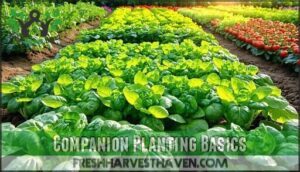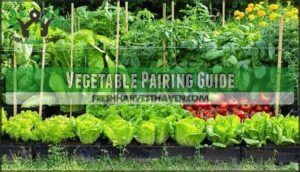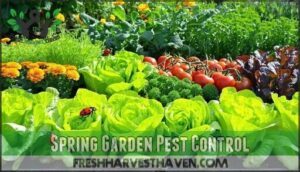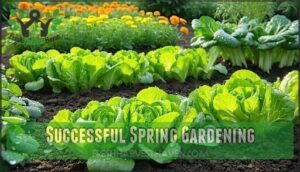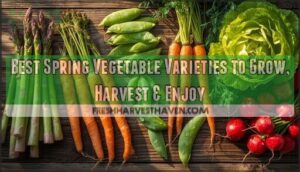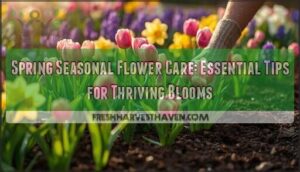This site is supported by our readers. We may earn a commission, at no cost to you, if you purchase through links.

Cool-season crops like carrots and radishes work perfectly together—radishes break up soil for carrots’ deep roots. Avoid planting competing families together, like brassicas with other brassicas.
Strategic spacing matters: tall plants should shade shorter ones appropriately. Plant marigolds throughout for natural pest control, and consider succession planting to maximize harvest timing.
The secret lies in creating beneficial relationships where each plant supports its neighbors’ growth, health, and productivity through complementary root systems and natural compounds.
Table Of Contents
- Key Takeaways
- Spring Vegetable Pairing
- Companion Planting Basics
- Vegetable Pairing Guide
- Spring Garden Pest Control
- Successful Spring Gardening
- Frequently Asked Questions (FAQs)
- What spring vegetables grow well together?
- What vegetables grow well together chart?
- What vegetables can and cannot be planted together?
- Which vegetables to plant in early spring?
- What is the rule of three companion planting?
- Which vegetables grow well together chart?
- What vegetables should you plant next to each other?
- What are the best vegetables to plant in spring?
- How do you plan a spring vegetable garden?
- What edible flowers can I plant with spring vegetables?
- Conclusion
Key Takeaways
- Pair nitrogen-fixing plants with heavy feeders – Plant peas or beans near nutrient-hungry crops like tomatoes and lettuce to naturally enrich the soil and boost growth
- Use aromatic herbs as natural pest deterrents – Plant basil near tomatoes, marigolds throughout beds, and onions around carrots to reduce pest problems by 30-90% without chemicals
- Match root depths and growth rates – Combine shallow-rooted lettuce with deep-rooted carrots, or fast-growing radishes with slower-growing cucumbers to maximize space efficiency
- Plan your layout with sunlight and spacing in mind – Place tall plants on the north side to prevent shading, create accessible pathways, and allow proper air circulation between companion pairs
Spring Vegetable Pairing
You’ll discover which spring vegetables work together like natural partners, creating stronger plants and better harvests through strategic companion planting.
Smart pairings protect your crops from pests while improving soil health, making your spring garden more productive with less effort, utilizing strategic techniques to enhance overall garden performance.
Choosing Compatible Vegetables
Choosing compatible vegetables sets up your spring garden for success.
Focus on Vegetable Harmony through similar growth rates and nutrient needs, creating natural Plant Partnerships.
Your companion planting guide should highlight beneficial combinations like tomatoes with basil for Garden Synergy, while avoiding conflicts such as onions near beans.
Crop Diversity through strategic vegetable pairing maximizes Soil Sharing efficiency.
Planting radishes and spinach offers quick harvests.
Creating a Garden Layout
Map out your spring garden by starting with Sunlight Mapping to position sun-hungry vegetables like tomatoes in the brightest spots.
Use Garden Mapping techniques to plan Plant Spacing based on mature sizes—sprawling cucumbers need room while compact lettuce can squeeze between larger plants.
Your Layout Design should place taller crops on the north side to prevent shading shorter neighbors.
Smart garden planning means creating accessible pathways for maintenance and harvest.
A well-thought vegetable garden layout using a companion planting chart guarantees each plant thrives in its perfect spot.
Remember, good garden planning today prevents headaches tomorrow when your spring vegetable planting takes off.
Preparing The Soil for Spring
Once you’ve designed your garden layout, soil preparation becomes your next priority. Soil testing reveals nutrient gaps and pH balancing needs for ideal spring vegetable planting. Transform ordinary dirt into garden soil fertility powerhouse through strategic organic matter additions.
Here’s your soil preparation action plan:
- Mix compost addition with existing soil at 2-3 inch depth
- Apply mulch layering around planting areas to retain moisture
- Adjust pH levels using lime or sulfur based on test results
- Complete fertilizer application two weeks before planting
Smart soil amendments create the foundation your vegetables crave. Understanding soil preparation basics is vital for a successful spring harvest.
Companion Planting Basics
You’ll transform your spring garden from a collection of individual plants into a thriving ecosystem where each vegetable helps its neighbors succeed.
Understanding which plants work together, what mistakes to avoid, and how compatibility actually works will turn your gardening efforts from guesswork into a science-backed strategy.
This strategy will deliver bigger harvests with less work, making your gardening more efficient and productive.
Benefits of Companion Planting
Smart companion planting vegetables create thriving spring gardens through proven benefits of companion planting.
**Strategic companion planting transforms ordinary gardens into pest-fighting, yield-boosting ecosystems that practically manage themselves.
Research shows these strategic partnerships deliver measurable results:
- Pest Deterrence – Basil reduces tomato hornworms by 52%, while marigolds cut nematodes by 90%
- Crop Yield – Three Sisters plantings boost harvests 20% per square meter
- Soil Health – Legumes fix 40-60 kg nitrogen per hectare for neighboring crops
- Space Efficiency – Intercropping lettuce with radishes speeds maturation by seven days
- Nutrient Boost – Natural pest control through diverse plantings reduces infestations 40%
These spring vegetable combinations improve vegetable yield while building sustainable garden ecosystems.
Understanding companion planting techniques is essential for maximizing garden productivity.
Common Companion Planting Mistakes
Three common companion planting mistakes can derail your spring garden before it starts.
Overcrowding plants creates competition for nutrients, while soil imbalance occurs when heavy feeders cluster together.
Incorrect pairing, like tomatoes near black walnut trees, stunts growth.
Insufficient research leads to failed combinations, and inadequate planning wastes precious garden space.
You’ll avoid these pitfalls by studying plant needs first.
Understanding Plant Compatibility
Understanding plant compatibility starts with recognizing how different vegetables interact below and above ground.
Your spring gardening tips become more effective when you consider these plant interactions and soil synergy.
- Nitrogen lovers paired with nitrogen fixers – like tomatoes with beans
- Deep-rooted vegetables sharing space with shallow companions – carrots with lettuce
- Pest-repelling herbs protecting vulnerable crops – basil guarding tomatoes
- Fast-growing varieties filling gaps between slower plants – radishes with cucumbers
Smart vegetable pairings create botanical harmony while garden diversity supports natural crop rotation patterns for healthier soil.
Vegetable Pairing Guide
Understanding which vegetables work best together can transform your spring garden from average to exceptional.
You’ll discover specific pairings that naturally repel pests, improve soil health, and boost your harvest yields without relying on chemicals.
Planting Tomatoes With Other Vegetables
Smart tomato companions can boost your harvest by up to 20%. Tomato basil pairing repels thrips while improving flavor, making it essential for vegetable layout planning.
Plant garlic and onions around tomatoes to reduce aphid infestations by 30%. Beans fix nitrogen, enhancing soil fertility for hungry tomatoes.
Avoid fennel and potatoes—they’ll sabotage your spring garden vegetables. Smart crop rotation and companion planting maximize garden efficiency through strategic vegetable pairing.
Understanding effective companion plant strategies is vital for a successful harvest.
Pairing Cucumbers With Companion Plants
Cucumbers naturally pair well with strategic companions that boost Soil Health and provide Natural Repellents. Smart Cucumber Pairings create a thriving ecosystem that maximizes Garden Efficiency through Pest Deterrence.
Cucumbers and companions create nature’s perfect pest-fighting partnership for maximum garden success.
Your cucumber companions work like a well-orchestrated team, each playing a pivotal role. Companion planting transforms ordinary cucumber patches into productive powerhouses that protect and nourish your spring garden vegetables.
Consider these proven pairing cucumbers strategies:
- Nasturtiums act as living shields, deterring cucumber beetles while boosting yields by 25%
- Radishes slash striped cucumber beetle populations by 50% through natural interference
- Beans enrich soil with nitrogen, supporting vigorous cucumber growth throughout the season
- Dill and oregano serve double duty as trap crops and aphid repellents
- Marigolds release thiophenes that suppress harmful nematodes in root zones
Understanding companion planting techniques is essential for optimizing garden space and yields. This vegetable pairing guide approach creates natural pest management while enhancing soil fertility, proving that the right neighbors make all the difference in your cucumber success.
Growing Carrots With Compatible Vegetables
Carrots make excellent neighbors when you choose the right companions for your spring vegetable garden.
Your best carrot companion choices include onions, which naturally repel carrot flies and reduce pest problems by up to 40%.
Chives work similarly, creating a protective barrier around your carrot rows.
For soil preparation benefits, pair carrots with radishes.
These quick-growing radish benefits include breaking up compacted soil, making it easier for carrot roots to penetrate deeply.
Lettuce also works well, using space efficiently while carrots develop underground.
Carrots flourish with onions as natural pest repellents, while rosemary and sage boost soil health and enhance their sweet flavor.
Smart companion planting means using herbs like rosemary and sage as pest deterrents while improving flavor.
These aromatic plants enhance your growing carrots naturally.
Remember crop rotation importance – avoid planting carrots in the same spot annually to prevent disease buildup in your spring vegetable garden.
Carrots flourish in well-planned gardens, and using herbs like rosemary can significantly improve their growth.
By following these guidelines, you can create a thriving and healthy spring vegetable garden with onions as natural pest repellents and lettuce for efficient space use.
Planting Peppers With Beneficial Neighbors
Peppers flourish alongside specific pepper companions that boost soil health and provide natural pest deterrence.
Planting peppers near basil creates powerful garden pairings—basil repels aphids while potentially enhancing pepper flavor.
Onions, spinach, and tomatoes also make excellent neighbors for companion planting.
However, avoid pole beans, which create tangled vines, and brassicas that compete for nutrients.
These strategic pepper pairings serve as pest deterrents and growth enhancers, supporting healthy crop rotation practices for long-term garden success.
Spring Garden Pest Control
Spring pest problems don’t have to ruin your garden dreams, and companion planting offers nature’s own pest control system that actually works.
You’ll discover how strategic plant partnerships can reduce harmful insects by up to 80% while attracting beneficial predators that keep your vegetables healthy and thriving.
Using Companion Plants for Pest Control
Through strategic companion planting, you’ll transform your garden into a natural fortress against pests.
Marigolds slash nematode populations by 80%, while basil cuts thrip damage on tomatoes by 36%.
Here’s your pest deterrence toolkit:
- Plant nasturtiums as trap crops – they reduce aphid infestations by 46%
- Use garlic near leafy greens for 40% fewer spider mites
- Add chives around carrots to lower carrot fly numbers by 40%
- Interplant alyssum with broccoli for 47% better aphid control
- Grow catnip near potatoes – it deters flea beetles by 60%
These organic methods boost soil health while attracting beneficial insects naturally.
Understanding companion planting herbs is key to maximizing the benefits of this approach.
Natural Methods for Controlling Garden Pests
The garden’s most effective defense starts with attracting nature’s own pest patrol. Encourage beneficial insects like ladybugs and lacewings by planting flowers such as alyssum and marigolds throughout your beds.
These natural repellents create an invisible barrier against harmful pests while supporting soil health. Companion planting with aromatic herbs like basil provides dual benefits—pest deterrence and fresh seasonings.
Trap cropping using nasturtiums draws aphids away from precious vegetables. When organic gardening tips aren’t enough, diatomaceous earth offers gentle pest control without harsh chemicals, keeping your spring harvest naturally protected.
Effective natural pest control methods are essential for a healthy garden ecosystem.
Maintaining a Balanced Ecosystem
The perfect garden resembles a thriving neighborhood where everyone contributes something valuable.
Your companion planting creates ecosystem services through natural nutrient cycling and biodiversity conservation. Marigolds improve soil health while providing wildlife support for beneficial insects.
This balanced ecosystem approach transforms your space into a self-sustaining system. Sustainable gardening means working with nature, not against it.
Organic gardening tips emphasize patience—ecosystem balance develops over time through thoughtful plant partnerships.
Successful Spring Gardening
Spring’s arrival brings fresh opportunities to maximize your garden’s potential through strategic companion planting.
You’ll discover how proper planning, weather management, and ongoing care create the foundation for a thriving vegetable garden that produces abundant harvests all season long.
Tips for Planting a Productive Garden
Building your spring garden planning success starts with smart soil preparation—test pH levels and work in compost before anything else.
Plan your vegetable garden design considering sunlight needs and space optimization. Start seeds indoors 6-8 weeks early, then transplant using companion planting guide principles.
A digital soil moisture meter helps avoid overwatering. Crop rotation prevents disease buildup while garden efficiency maximizes yields.
Deep, consistent watering develops strong roots without encouraging disease.
Managing Spring Weather Conditions
Throughout spring’s unpredictable weather patterns, you’ll face multiple challenges that can derail your companion planting success. Smart frost protection and strategic watering strategies become essential when temperatures fluctuate unexpectedly.
Your spring garden planning should include these weather management techniques:
- Use row covers to maintain soil temperature 4-8°F warmer during cold snaps
- Install windbreaks for wind mitigation, reducing seedling damage by 30%
- Position beds for ideal sun exposure, especially south-facing locations
Managing spring weather requires preparation over panic for your successful spring garden.
Maintaining a Healthy and Thriving Garden
Smart soil health monitoring sets the foundation for your healthy vegetable garden success.
Check your garden weekly, testing moisture levels and adding compost when nutrients run low. Early morning watering techniques prevent fungal diseases while maximizing water absorption. Your spring vegetables thrive when you stay ahead of problems rather than chasing them.
Essential garden monitoring practices include:
- Soil Health: Test pH monthly and add organic matter to maintain healthy plant nutrition
- Watering Techniques: Water deeply but less frequently to encourage strong root development
- Weed Control: Remove weeds immediately before they compete with your companion planting arrangements
- Plant Nutrition: Apply balanced fertilizers every 3-4 weeks during peak growing season
This vegetable garden guide approach guarantees your best companion plants work together effectively, creating a thriving ecosystem that practically runs itself.
Frequently Asked Questions (FAQs)
What spring vegetables grow well together?
Peas and carrots shine together in March, while spinach and radishes make perfect partners.
Try lettuce with onions for pest control, or plant beans near potatoes for nitrogen-fixing magic that boosts growth naturally.
What vegetables grow well together chart?
Absolutely mind-blowing combinations will transform your garden!
You’ll discover tomatoes pair with basil and marigolds, corn teams with beans and squash, while carrots thrive alongside chives and onions for pest control.
What vegetables can and cannot be planted together?
You’ll want to pair complementary plants while avoiding competition. Plant tomatoes with basil and marigolds, but keep them away from fennel. Carrots love onions but hate dill nearby.
Which vegetables to plant in early spring?
Like awakening seeds breaking through winter’s grip, you’ll want to plant cool-season champions in early spring. Try peas, spinach, lettuce, radishes, carrots, and onions—they’ll thrive in chilly soil.
What is the rule of three companion planting?
The "rule of three" in companion planting refers to the famous "Three Sisters" combination: corn, beans, and squash planted together.
Each plant supports the others through structure, nitrogen fixation, and ground coverage, making this combination a notable example of symbiotic gardening.
Which vegetables grow well together chart?
While some vegetables clash like stubborn roommates, others partner beautifully. Try tomatoes with basil, corn with beans, carrots with chives, lettuce with radishes, and cabbage with marigolds for proven combinations.
What vegetables should you plant next to each other?
Plant tomatoes with basil for pest control, carrots with onions to deter flies, and corn with beans for nitrogen-fixing. These proven combinations boost growth and reduce pesticide needs naturally.
What are the best vegetables to plant in spring?
March through May offers your garden’s golden ticket for success. Plant cold-hardy favorites like peas, carrots, and lettuce first, then move on to warm-season champions like tomatoes, beans, and peppers.
How do you plan a spring vegetable garden?
Start by evaluating your space, sunlight, and soil conditions. Choose quick-growing crops like lettuce, radishes, and peas that tolerate cool weather. Plan companion pairings strategically for maximum benefits.
What edible flowers can I plant with spring vegetables?
Nasturtiums trap aphids beautifully, while marigolds deter nematodes and whiteflies. Borage attracts beneficial pollinators to your vegetables, and you’ll love snacking on their cucumber-flavored petals in salads too.
Conclusion
Who knew that your garden could have better relationships than some people?
Using this companion planting guide for spring vegetables, you’ll set up your crops to support each other, fight pests, and grow stronger together.
Remember, plants don’t gossip, but they do help their neighbors thrive.
With strategic pairing, smart spacing, and a touch of planning, you’ll boost your harvest and enjoy a healthier garden.
So, grab your seeds and let your veggies be the best companions this spring.

